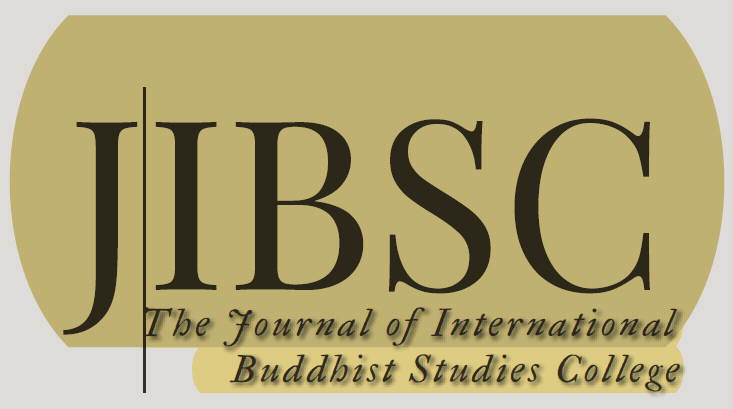Buddhist Peaceful Means in Shopping Addiction Treatment: Integration of Mindfulness, Yoniso Manasikara (Wise attention), and Loving-Kindness in a Novel Therapeutic Model
Keywords:
Shopping addiction, Buddhist Psychology, Buddha’s Teaching of Mindfulness, Yoniso manasikara (wise attention), Loving-kindnessAbstract
This article presents a study focused on (1) the integration of three key Buddhist psychological principles—mindfulness (sati), wise attention (yoniso manasikara), and loving-kindness (metta)—in the treatment of compulsive buying disorder (CBD), (2) the creation of an innovative therapeutic framework that incorporates traditional Buddhist contemplative practices, and (3) the practical implications for clinical applications and future research directions. The methodology for data collection involved a systematic analysis of canonical Buddhist texts and contemporary clinical research, specifically examining the Satipatthana Sutta, Sabbāsava Sutta, and Metta Sutta, as well as their accompanying commentarial literature. Data analysis was conducted using descriptive statistics and content analysis. The findings of this research
include:
- Integrating mindfulness, yonis manasikara, and loving-kindness yields synergistic effects that surpass the benefits of each practice in isolation, thus creating a comprehensive framework for addressing shopping addiction at cognitive, emotional, and behavioral levels.
- The development of “consumption discernment”—a refined cognitive capacity that emerges through the fusion of yoniso manasikara with other contemplative practices—enhances metacognitive awareness, value-based discrimination, and emotional intelligence concerning shopping behaviors.
- A novel framework for adapting Buddhist contemplative practices to contemporary therapeutic contexts has been established. It provides systematic guidelines that maintain the transformative power of these practices while ensuring their accessibility to modern clients.
References
Armstrong, A., & Williams, S. (2018). Neurological mechanisms of mindfulness in shopping addiction treatment. Journal of Clinical Psychology, 74(8), 892–908. https://doi.org/10.1002/jclp.22598
Bhikkhu Anālayo. (2020). Mindfulness in early Buddhism: Characteristics and functions. Windhorse Publications.
Bhikkhu Anālayo. (2021). Superiority Conceit in Buddhist Traditions: A Historical Perspective. Simon and Schuster.
Black, D. W., Shaw, M., McCormick, B., Bayless, J. D., & Allen, J. (2016). Neuropsychological performance, impulsivity, ADHD symptoms, and novelty seeking in compulsive buying disorder. Psychiatry Research, 235, 129–136. https://doi.org/10.1016/j.psychres.2015.11.030
Creswell, J. D., & Lindsay, E. K. (2019). How does mindfulness training affect health? A mindfulness stress buffering account. Current Directions in Psychological Science, 28(6), 401-407. https://doi.org/10.1177/0963721 414547415
Davidson, R. J., & Dahl, C. J. (2023). Integrating contemplative practices with contemporary psychology. Annual Review of Psychology, 74, 485–514.
Garland, E. L., Hanley, A. W., Nakamura, Y., & Froeliger, B. (2021). Mindfulness-oriented recovery enhancement reduces opioid misuse risk via neurocognitive mechanisms. Science Advances, 7(9), eabf0868. https://psycnet.apa.org/doi/10.1037/ccp0000390
Goldberg, S. B., Tucker, R. P., Greene, P. A., Davidson, R. J., Wampold, B. E., & Kearney, D. J. (2021). Mindfulness-based interventions for psychiatric disorders: A systematic review and meta-analysis. Clinical Psychology Review, 84, 101972.
Hanley, A. W., Nakamura, Y., & Garland, E. L. (2020). Mindfulness-based interventions for addictive behaviors: Clinical implications and future directions. Substance Use & Misuse, 55(14), 2310-2321.
Hussain, S., Raza, A., Haider, A., & Ishaq, M. I. (2023). Fear of missing out and compulsive buying behavior: The moderating role of mindfulness. Journal of Retailing and Consumer Services, 75, 103512. https://doi.org/ 10.1016/j.jretconser.2023.103512
Hytman, L., Amestoy, M. E., Ueberholz, R. Y., & Fiocco, A. J. (2025). Cultural Adaptations of Mindfulness-Based Interventions for Psychosocial Well-Being in Ethno-Racial Minority Populations: A Systematic Narrative Review. Mindfulness, 16, 21–41. https://doi.org/10.1007/s12671-024-02501-81-21.
Kabat-Zinn, J. (2013). Full catastrophe living: Using the wisdom of your body and mind to face stress, pain, and illness (Rev. ed.). Bantam Books.
Kabat-Zinn, J. (2019). Falling awake: How to practice mindfulness in everyday life. Hachette UK.
Kim, H., & Lee, J. (2023). Neural correlates of compulsive buying disorder: Insights from functional neuroimaging studies. Journal of Behavioral Addictions, 12(1), 45–59. https://doi.org/10.1556/2006.2023.00012
Maraz, A., Griffiths, M. D., & Demetrovics, Z. (2016). The prevalence of compulsive buying: A meta-analysis. Addiction, 111(3), 408–419. https://doi.org/10.1111/add.13223
Mueller, A., Mitchell, J. E., & de Zwaan, M. (2015). Compulsive buying. The American Journal on Addictions, 24(2), 132–137. https://doi.org/10. 1111/ajad.12111
Mueller, A., Mitchell, J. E., Crosby, R. D., Gefeller, O., Faber, R. J., Martin, A., & de Zwaan, M. (2015). Medication use in compulsive buying disorder. Journal of Clinical Psychopharmacology, 35(5), 563–568. https://doi. org/10.1097/JCP.0000000000000405
Mueller, A., Mitchell, J. E., Crosby, R. D., Gefeller, O., Faber, R. J., & de Zwaan, M. (2015). Cognitive-behavioral group therapy versus guided self-help for compulsive buying disorder: A randomized pilot study. Journal of Behavior Therapy and Experimental Psychiatry, 46, 189–197.
Rosenthal, A., Levin, M. E., Garland, E. L., & Romanczuk-Seiferth, N. (2021). Mindfulness in treatment approaches for addiction—underlying mechanisms and future directions. Current Addiction Reports, 8, 282-297. https://doi.org/10.1007/s40429-021-00372-w
Rotstein, H. G., & Santamaria, F. (2022). Development of theoretical frameworks in neuroscience: a pressing need in a sea of data. https://doi.org/10. 48550/arXiv.2209.09953
Shonin, E., Van Gordon, W., & Griffiths, M. D. (2014). The emerging role of Buddhism in clinical psychology: Toward effective integration. Psychology of Religion and Spirituality, 6(2), 123–137. https://doi.org/10. 1037/a0035859
Shonin, E., Van Gordon, W., & Griffiths, M. D. (2016). Buddhist-derived loving-kindness and compassion meditation for the treatment of psychopathology: A systematic review. Mindfulness, 7(2), 327–342. https://doi.org/10.1007/s12671-015-0407-6
Shonin, E., Van Gordon, W., & Singh, N. N. (Eds.). (2015). Buddhist foundations of mindfulness. Springer International Publishing.
Van Gordon, W., Shonin, E., & Garcia-Campayo, J. (2021). Are there two types of mindfulness? Comparing mindfulness traditions and contemporary psychological approaches. Mindfulness, 12(5), 1021-1033.
Van Gordon, W., Shonin, E., & Griffiths, M. D. (2023). Buddhist-derived interventions for behavioral addictions: A systematic review and meta-analysis. Clinical Psychology Review, 96, Article 102252. https://doi.org/ 10.1016/j.cpr.2023.102252
Wallace, B. A. (2011). Contemplative science: Where Buddhism and neuroscience converge. Columbia University Press.
Wang, V., & Stone, B. M. (2022). Buddhism in addiction recovery. Encyclopedia, 2(1), 530-537. https://doi.org/10.3390/encyclopedia 2010035
Zeidan, F., Johnson, S. K., Diamond, B. J., David, Z., & Goolkasian, P. (2019). Mindfulness meditation improves cognition: Evidence of brief mental training effects on perceived stress and executive control. Frontiers in Aging Neuroscience, 11, 229. https://doi.org/10.1016/j.concog.2010. 03.014
Downloads
Published
How to Cite
Issue
Section
License
The Journal of TCI is licensed under a Creative Commons Attribution-NonCommercial-NoDerivatives 4.0 International (CC BY-NC-ND 4.0) licence unless otherwise stated. Please read our Policies page for more information on Open Access, copyright and permissions.





